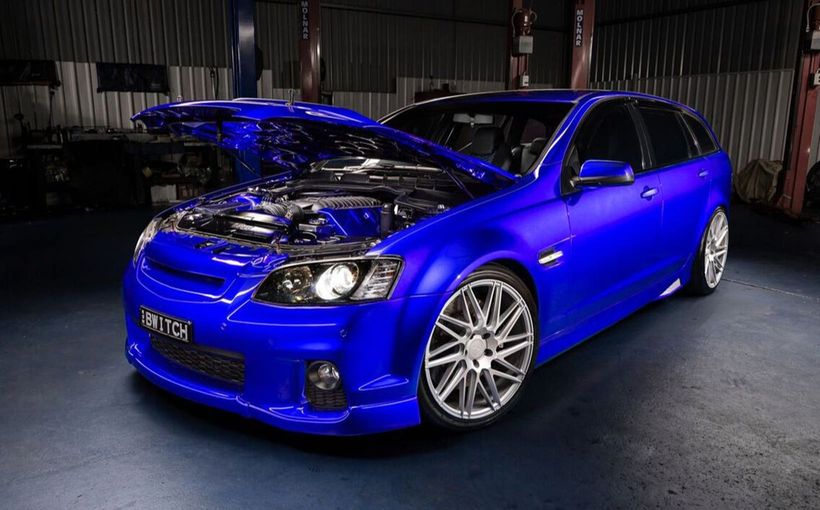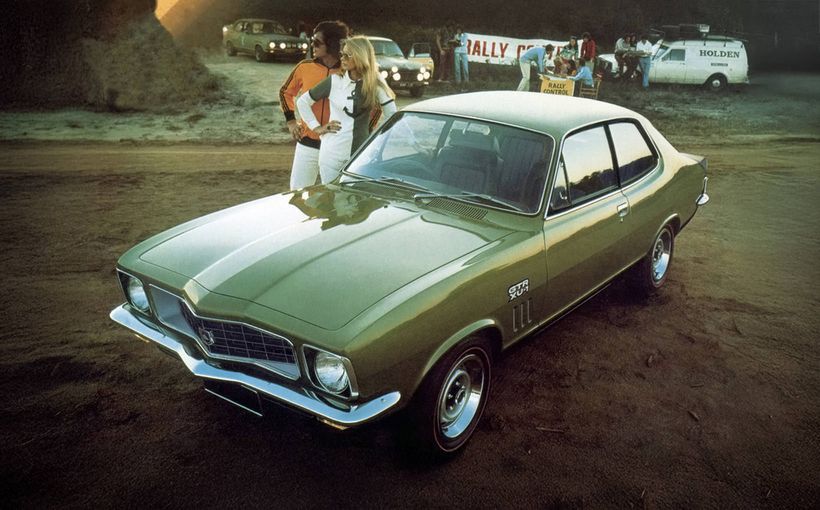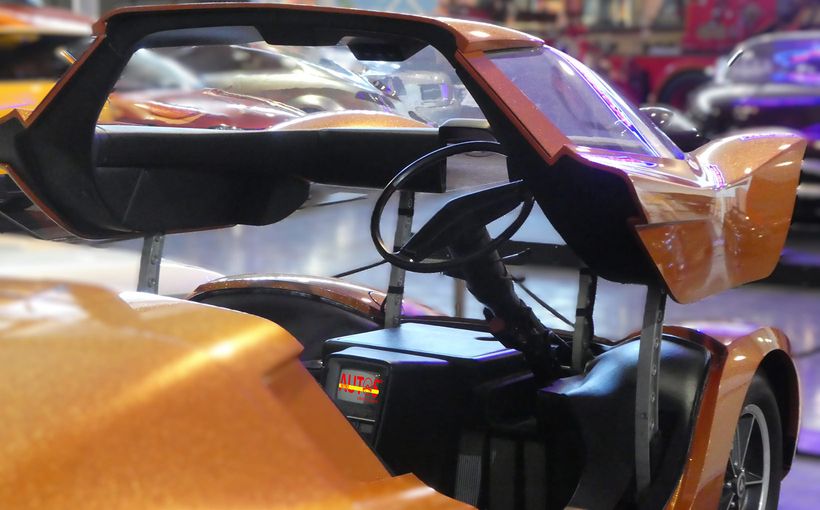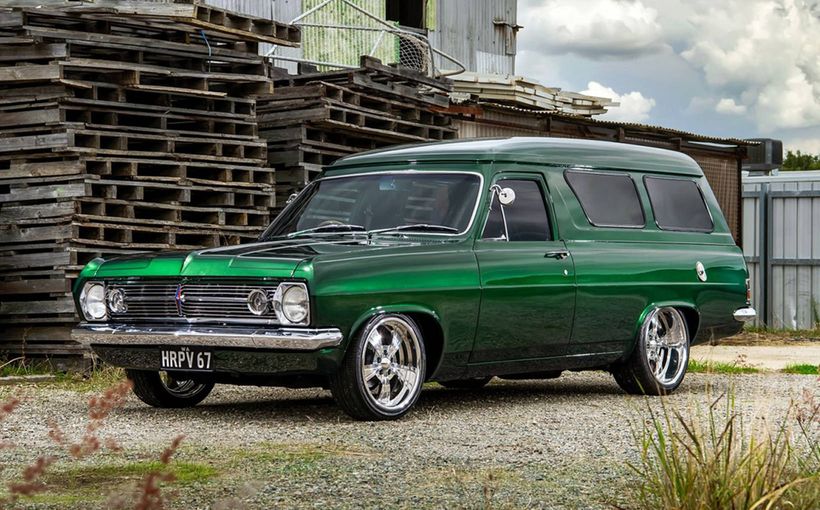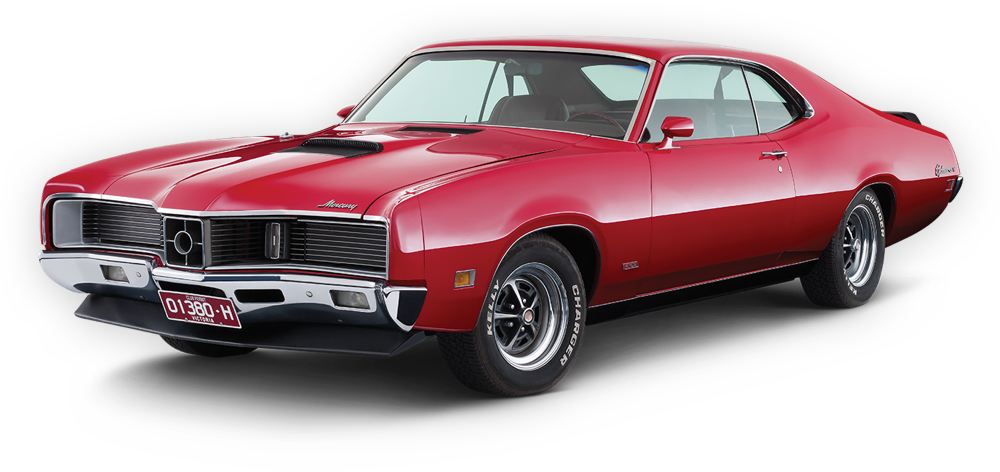HSV GTS 215i: Swifter, stronger stroker stunner

When time is so precious it's saved and shaved in tenths of a second, Holden Special Vehicles' GTS 215i is a car of rare value. Transport from inm1obile to a place 400 metres distant in 14.8 seconds is something special. And so is nothing to 100 km/ h in 6.6 seconds.
Dial up 3000 on the tach, hold the revs stable with a steady right foot, then lift eyes from the dial to the view through the screen. The strip stretches ahead, inviting the fi.1ry to come. Feel out the beginning of Dutch bite with the left foot. Ah, there it is. Slip for a second off the line, then flatten the accelerator. Shrieking and squirming, the 215i goes feral, mashing the driver and passenger alike into the heavily bolstered seats.
Stab and tug clutch and lever. Again the tyres complain, though not so bitterly. The surge in second is scarcely less fierce. Third, as in any good gearbox, is swept home with a solid thrust of the left palm. Don't worry about the dogleg, let the springs do the work.
By now the end of the strip is rushing nearly 40 metres closer every second. Holding the throttle flat, snatch fourth. Revs flare to the limiter for a split second.
And still the force is with us ...

A handful of cars sold in Australia today are capable of similar swiftness, and not one of them is made here. Sift through two decades or so worth of Fords, Holdens and Valiants and there are few which might match this 5.7litre V8's mastery of time and distance. Leading the list are the Ford XY Falcon GTHO Phase III and Valiant Charger R /T E49. Holden's own contribution to the · golden age of local supercars between '67 and '72, the Monaro 350 GTS, is seriously overshadowed by the new GTS.
So, HSV's 215i is obviously among the quickest accelerating production cars ever made in Australia. It might be quickest of all. Just maybe, because there's no simple, straightforward answer to the question. It's one we try to address on page 39.
What HSV's product does have, without any ifs, buts or maybes, is Australia's highest ever production car top speed. On Holden's Lang Lang bowl, the best high-speed venue in the country, the GTS 215i ran a genuine, Correvit-recorded 243 km/ h. In the fifth of its six forward speeds. We don't know of any equally well docun1ented, higher top speed.
None of the 20-plus-year-old muscle cars could, in their day, manage the metric equivalent of 150 mph. Four speed gearboxes were the rule, and aerodynamics were Neanderthal. No previous HSV product has broken the 240 barrier. Tickford's most potent XR-rated Falcons, and the '92 Anniversary Falcon GT, have likewise nm in the 220-230 km/h bracket when tested, Correvit equipped, by Wheels.
The GTS 215i is faster than them all. But to concentrate solely on the data that defines performance is to miss a very large part of the point. The Phase III, E49 and 350 Monaro, though legendary, are also products of a simpler and more brutal age. All three were built to burn super grade leaded fuel in vast amounts, with little regard to the noise and filth generated. They're from a time when green was just another colour, not a political affiliation.

HSV's 215i, in accordance with the laws of '94, must create minimal pollution and make very little noise, while burning less potent fuel. It must also conform with a plethora of other regulations which ensure that it's totally safe to drive and not too unsafe to crash. In the late '60s and early '70s Australian Design Rules were comparatively few in nun1ber and easily satisfied.
Regulation, though, is just one aspect of the story Technology, too, has marched a long way in two decades. It's true the pace has been forced by legislation in some respects. But the laws enforce only minimum standards. No-one insists, for instance, that tyres as excellent as the GTS 215i's 235/ 45ZR17 Expedia S-O1s be fitted.
A contrast. The GTHO Phase III ran (as tested by Wheels in 1971) 70 profile Dunlop Aquajets on its six inch wide, 14 inch diameter rin1s. The Charger and Monaro had the same size tyres from Goodyear and Olympic respectively. All pre-dated the beginning of the steel radial revolution, and therefore any resemblance to modern day expectations of grip. There is apparent concensus about what size tyres a legendary Australian-made supercar should wear, but in today's terms they're not the best way to deliver from 400-and-something to 500-plus Nm of torque - as was claimed for all three of these cars - to the bitumen. There's not a lot of cornering grip either. And braking, by modern standards, is feeble. This isn't only the fault of the tyres. Drum rear brakes also contribute. Our original road tester complained of bad fade after just two hard stops in the GTHO Phase III back in '71. Ditto for the E49 a year later.
And, while the rose coloured glasses are off, let's not forget skinny plastic-rimmed steering wheels, and the feel-free unassisted mechanisms they were connected to. Nor heavy clutches and clunky gearboxes with sluggish syncho. And slippery, shapeless vinyl covered seats. And noise, lots of it.
But despite all this, or perhaps because of it, the Monaro, Falcon and Charger are exciting cars. When they’re going fast – and there's no question they can - they feel very damned fast indeed. Their exhausts bellow in antique defiance of ADR 28. Their tyres scrabble and squeal. It's raucous drama and danger - tinged excitement.
The GTS 215i is every bit as exciting, if not so dramatic. And quicker by an indecent degree. On any racetrack, or on any piece of public road, anything with corners in it, the GTS 215i will brake later and harder, be faster as it nips the apex of a bend and will power out with greater punch.
Those tyres, perhaps more than any other single thing, account for the HSV car's prodigious grip and delicious handling. But if the engine didn't have such towering torque, the brakes didn't have such reliably ferocious bite and there wasn't a clever slip-limiting device inside t11e differential casing, the GTS 215i wouldn't be nearly so fine a package. While nose-heavy weight bias and chassis tune means the HSV stroker is basically an understeering car, the 5.7litre makes it wonderfully throttle adjustable. It's the driver's choice. Flick the car into a bend, get on the throttle early and hold it in oversteer. Or just turn in and then apply Newton metres as required to neutralise understeer or turn it into oversteer.

The transition from scuffing the front tyres to slipping the rears is smooth and benign. Hydratrak is HSV's secret. Invented (patent pending) and made by BTR in Australia, Hydratrak is a superior limited-slipper. The short description is that it's a cartridge-type fluid coupling which progressively and smoothly increases torque transfer to the wheel with slower rotation. For a more detailed picture, turn to page 36.
What's important here is Hydratrak's gentle feeding of torque to whichever rear wheel isn't spinning. There's no sudden rush of twist to upset the car's cornering attitude, just a gradual feeding of drive to the tyre which is gripping the road.
This ain't a characteristic of the usual mechanical limited-slipper, which comes in with a bang, disturbing any attitude that's been established.
The 5.7 was always going to need something like Hydratrak, even though the decision to use it was made only in the middle of '93. Right from the beginning of the program, in early '92, HSV was shooting for a 215 kW target. The aim was always to match the 5.0 litre VN Group A's output.
The process began with the assembly of feasibility engines by HSV's engineers, using a bought-in 88 mm stroke Harrop crank - an 11 mm increase - in a VN Group A engine with standard 102 mm bore.
"At the time we were talking about using the Group A manifolds, maybe, and all sorts of possibilities," says HSV's engineering manager John McInerney. "We took an old Group A engine, with the four bolt bottom end and all that, and we had one of those aftermarket crankshafts that Harrop makes and we put that in there, and it gives you 5.7 litres. And we ran that, we ran a couple of variations and it showed we were getting like about 230 kW, or something, quickly. So we said, 'Hey, that's done'.
"The drivability of this original engine that we ran on the dyno and got this nice big output was typical hot rod - lumpy idle, lots of shortcomings. Totally uncommercial, but typical of a home-made hot rod car out there. That's about three weeks' work. We've taken a couple of years over it and all the difference between three weeks and a couple of years is to get the drivability perfect."
And it is a deliciously drivable engine, every bit as civilised as it's stirring. The stroker's delivery is a winning argument that too much torque is just the right amount.
The peak value is 475 Nm at 3600 rpm - what's more important is the way the engine makes hundreds of Newton metres right from the moment the ignition key is turned. Across the rev range the curve is fat and smooth.

With so much torque, the 5.7 litre engine doesn't need to rev really hard to make its power. The 215 kW arrives at 4800 rpm, even though the redline is drawn at 5500 and the rev limiter lurks just beyond.
All this in contrast to the VN Group A. That engine, designed first to aid the cause of rev-hungry Commodore racers and only second as a road car power plant, made its 215 kW at 5200. The 5.0 litre engine's torque maxed at 411 Nm at 4800 rpm.
Though the '92 feasibility study stroker was basically Group A, the '94 production 215i is a quite different proposition. Much of the hardware will be familiar from last year's 5.0 litre 185 kW package. That's because benefits of the 215i program trickled down to the smaller, less powerful engine, which was ready for market earlier.
Consequently the stroker shares the little engine's cold air feed system, low restriction air cleaner and exhaust headers. The 215i's strengthened camshaft drive components, on the other hand, are a lift from HSV's 200 kW 5.0 litre. No trace of the Group A remains.
The core of the stroker is obviously the crank. It's cast by Holden's Engine Company, which builds the engines- there's no delving into the V8s at HSV's Melbourne assembly facility. The crucial process of crank machining is shared between HEC and Harrop.
Pistons giving 8.5:1 compression are installed, along with camshaft, exhaust valves, valve springs and flywheel specific to the 5.7 litre. Rods are standard forgings and the usual length, but are a specific weight to suit.
The compression ratio drop was forced by a HSV company policy which says all its cars should run sweetly on regular 92 octane unleaded, in the event owners aren't able to obtain the recommended premium 96 octane. Burning regular ULP at 9.0:1 compression, some proto strokers were nudging into the detonation zone.

But of all the problems faced and overcome during the stroker's development, the toughest job was the exhaust system. Early in the program it became obvious that HSV's Plan A - to use existing 200 kW 5.0 litre engine gear - simply wasn't going to work. The prototypes were only making about 205 kW While the 215i's stainless steel system looks very similar to that of the 200 kW - the little resonators have disappeared and there are twin oval outlets from the rear muffler - it's very different inside.
"The mufflers are lunching off the development that Walker (which make the exhaust) did in the States for the Viper," explains McInerney "Noise is amazing. The big breakthrough on this - can you believe it? - is the shape of the holes in the tubes. So the tube that runs through the centre of the muffler has got perforations in it and the shape of these perforations is what's made all the difference. Basically the mufflers are straight-through, but there's no noise coming out the back. We've got less restriction in this system than we had in the SV5000, which was substantially noisier."
The quiet giant's clutch is special too. Like every other VR Commodore it's got a cable, unlike any other VR Commodore it's hydraulic. The hybrid system was made necessary by HSV's adoption of a Chevrolet clutch and its pull-type disengagement mechanism. Incorporating a light alloy pressure plate body, the clutch is used in Chevys with the LTl V8 option.
Making it work in a Commodore took some HSV ingenuity. A specially manufactured cable runs from the pedal to a special cast alloy casing that bolts onto the clutch housing. Inside it is a pivot, a lever and a hydraulic master cylinder. The slave cylinder is fitted on the other side of the bell housing.
Two things. First, the self-adjusting nature of the hydraulic system allows the stroker to be fitted with cruise control. This can't be done with the common Commodore's cable clutch.
Second, pedal effort is relatively light. Considering how much force it takes to clamp 475 Nm to a gearbox, it's remarkable.
The gearbox in question is a six speeder, one of Borg Warner's new generation of manuals for the '90s. Though the designation of this US-made transmission is T56, it's no development of the current Commodore's T5 five speeder. It's a brand new box.
Ratios are spread wide. Think of it as a normal five speeder with an ultra-overdrive added. The T56's ratios, along with the 3.45:1 differential, give very similar overall gearing to the VN Group A. So sixth is a moonshoot 0.50, which gives 100 km/h at not much more than idle speed. Fuel consumption benefits accordingly. Like around 11 L/100 km in highway cruising. Calling on the 5.7's full surplus of thrust will obviously increase consumption considerably.
Using the gearbox is no chore, which is in definite contrast to the notchy, clunky ZF six slotter of the VN Group A. The forward speeds are on a double H pattern, reverse on a left-and-up dogleg. An electronically actuated lock-out prevents engagement at any speed above walking pace.

Though it's not lightning quick, the T56 has a well-defined gate and nicely mechanical feel. Somehow it's right in tune with the engine it serves.
There's only one fault. At 120 km/h in sixth there's an annoying harmonic beating. In top - and top only - something in the gearbox vibrates in near harmony with some other vibration source in the car.
The 5.7's brakes, on the other hand, are the best stoppers yet from HSV. Rotors all round are new, with curved vane ventilation to curb any tendency to cracking under extreme heat. Diameter is 330 mm at the front, and the standard Holden 280 mm at the rear.
Twin piston calipers clamp the 28 mm thick front rotors, and big bore single piston calipers squeeze the 20 mm rears. ABS is standard.
Power and consistency are the hallmarks of the 215i's brakes. The pedal may feel too soft underfoot for some tastes, but there's no arguing the stoppers' fierce effectiveness.
If there's just one thing - besides the sixth gear harmonic - which might make this car just a little hard to live with it's the unrelenting firmness of the GTS's Sports suspension calibration. On neglected rural roads its bucking ride is not endearing. The Touring calibration for the more expensive and more luxuriously equipped Senator 215i, based on past experience, is better. But some handling sharpness is sacrificed in the pursuit of comfort.
What must be obvious by now is that HSV's 215i is about much more than an 11 mm increase in engine stroke. It's a total engineering package of great depth and incredible thoroughness. Given the complete and conscientious job that HSV has done, it's impossible to quibble with their prices. When launched in mid-April the tags should be $58,500 for the GTS and $64,500 for the Senator. Manual only at first, autos are on target for October release.
"We see this car as absolutely vital for our in1age," admits John McInerney. "It sets the scene for HSV. Are we a company that puts spoilers on cars? Or are we what we want to be?"
If HSV wants to make the country's fastest production cars, mission accomplished. The 215i is a new Australian made performance benchmark. It will one day be a legendary car, for its numbers, if nothing else. But that's mything the point...

Go Back in Time with the Wheel Archive. Get FREE access to 5 years of Wheels archive content now!
Protect your HSV. Call Shannons Insurance on 13 46 46 to get a quote today.




